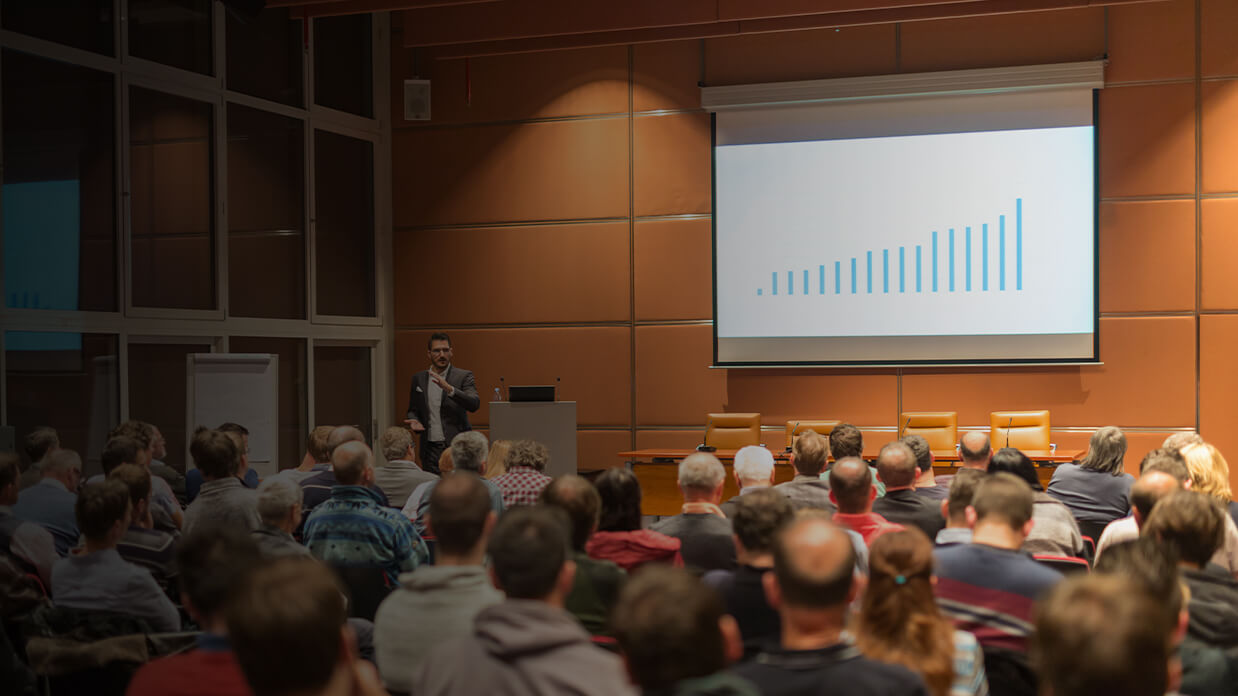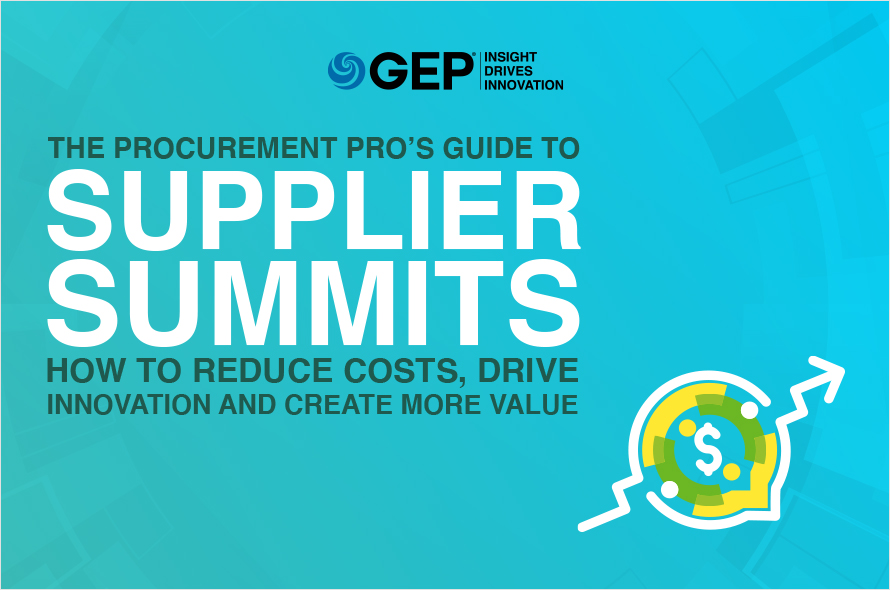Does saving costs have to mean strong-arming your suppliers?
It may seem like the most speedy, direct way to achieve your goal, but squeezing your vendors is not necessarily the best, or the most effective, solution.
In our latest bulletin, The Procurement Pro’s Guide to Supplier Summits: How to Reduce Costs, Drive Innovation and Create More Value, GEP’s sourcing experts present supplier summits as a viable alternative. They detail the best timing for such events, how procurement teams can plan and execute them successfully both in the physical and virtual space, and the benefits of this approach in building relationships and driving innovation.
What’s Inside:
- What supplier summits can bring to the table
- Impact of summits across various spend categories
- Why executive buy-in and involvement are crucial
A must-read for procurement teams looking for quick wins without alienating their suppliers.
Even as the global economy slowly inches toward recovery, many enterprises continue to face a host of new challenges that are affecting their profitability. Rising commodity prices and shortages combined with the growing CPI and PPI, which signal inflation, have increased margin pressures. Procurement teams in these organizations are tasked with overcoming these challenges by increasing savings and cash flow to improve EBIT performance as quickly as possible.
Traditional sourcing strategies, such as RFxes/auctions, can yield results, but may be constrained by a lack of time, data and/or buy-in. Pressuring your key suppliers for price cuts is another option, but it may be just a one-time fix. Or worse, it could backfire, with your suppliers refusing to relent on pricing or walking away, which will cause a new headache. What, then, can procurement do to optimize costs without delay?
Enter supplier negotiation summits. GEP’s experience has shown that this targeted approach not only unlocks value in the short term, but is also sustainable over multiple years.
Benefits of Supplier Summits
Supplier negotiation summits help procurement organizations and suppliers collaborate, achieve quick-hit EBIT savings, foster innovation and generate sustained price improvements without eroding supplier margins.
Summits also allow suppliers to interact with and hear from end users, procurement personnel and other stakeholders who use their products and services, thereby strengthening the relationship between the supplier and their customers. They require detailed planning and heavy lifting from procurement, but they can drive significant value if the right goals and objectives are set.
How To Execute a Successful Summit
Supplier summits have typically been executed in person over a few days, depending on the scope and number of suppliers involved. However, over the past year, GEP has found that virtual engagements have been just as successful. Below we discuss the fundamentals of supplier negotiation summits and provide best practices for their successful execution.
The Right Timing
Though there is no “best” time to start planning and preparation, GEP’s experience with organizing summits for various clients has shown that a good time to start any planning activity internally is Q3/Q4. This is typically when most enterprises refresh their procurement strategies and/or ideate for the following year. Summit planning can be a complementary exercise to this.
Similarly, the beginning of the calendar year is the best time to start communicating and working with suppliers toward an event that can be held in Q1/Q2. There are two reasons for this: suppliers have a full budget, so it’s easier to offer savings and it provides the maximum in-year savings impact for your enterprise.These timings are ideal scenarios, but GEP has conducted successful supplier summits throughout a calendar year.
Team Selection and Planning
Procurement should not be the sole planner and executor of the summit. It is important to involve various stakeholders that work with the suppliers and use their products/services. The roles and responsibilities around planning, communications, and negotiation strategy must be allocated and distributed appropriately.
It’s a best practice to have executive buy-in at the planning stage itself. It helps rally various functions behind a single objective internally, provides an escalation and resolution path during the planning process, and keeps work on track.
Finally, procurement, other stakeholders and executives must be aligned on the summit’s objectives, which are usually EBIT savings, cash flow improvement, supplier innovation and relationship management.
Supplier Selection
Summit negotiations are more than just selecting your top 25 or 50 suppliers. Procurement should collaborate with its business partners to identify the criteria for supplier selection, which should include:
- Supplier spend
- Where the supplier is in the contract term
- How critical the supplier’s product/service is to the enterprise’s day-to-day operations
- How much buying power you can exert
Additionally, some commodities/categories are more suited to summit-style negotiations than others (see table).
How Supplier Summits Work Across Categories
Source: GEP
Communication
Internal (within the enterprise) and external (with suppliers) communications are critical to the summit’s success. It is important to signal to invited suppliers that this is not another price reduction ask, but rather a joint exercise to achieve both financial and productivity goals. Suppliers today have a much better understanding of where an opportunity for improvement lies.
Internally, it is important to communicate (via different forums) the objective and the process around the summit so that everyone is aligned; you can engage executive leadership in this exercise. It is also imperative to communicate constantly that everyone keep an open mind toward ideas/opportunities that may come up during supplier discussions and negotiations. The summit’s goal is to have an open, creative dialog around possible improvements, so nothing should be off the table – including ideas that may have been rejected in the past.
Negotiation Preparation
In addition to asking suppliers to come prepared with cost-reduction opportunities, it is essential to make a plan internally. Spend and contract analysis, identifying various negotiation levers (both for short- and long-term savings) and putting together negotiation scripts and roles for various parties involved (procurement, end users, business stakeholders, etc.) are important for success.
The Event
The in-person summit events that GEP has organized for its clients usually span multiple days. Supplier representatives are either hosted on a company campus or at a convention center where adequate space is available for joint problem-solving sessions and negotiations and any speaker sessions/roundtables, plus informal networking events. When hosted virtually, the summit can span a couple of weeks based on mutual availability.
In either case, it is important to leverage available resources (including consultants/advisors) in these sessions, both to facilitate conversations and to record/document the discussions and quantify outcomes.
Lastly, have executive leadership present for important negotiation sessions, as well as for speaker sessions and roundtables. The latter provides a platform for suppliers to hear straight from the C-suite about the company’s priorities and future strategies, as well as the opportunity to network with them in a more relaxed environment.
Value Capture and Follow-Ups
Once negotiations are complete and there’s alignment on a future deal structure, savings need to be recorded. This is where a value capture office comes in — to keep track of the value achieved and follow-up items. Establishing this ahead of time and ensuring all data and communications are in a single repository will make it easier to record and report benefits. In many cases, follow-ups may be needed with both suppliers and business stakeholders to further vet and refine opportunities, so maintaining an action log with due dates is a best practice.
Summits are not one-and-done events. They can be an excellent bridge for future opportunity pipeline discussion and development. They are a powerful tool to help deliver a quick financial shot to P&L while adding significant long-term value and helping strengthen strategic relationships with internal and external partners.
In addition to the considerations and best practices we have discussed, it would be valuable to have a strategic partner that can facilitate and co-own all the moving parts that go into the planning, preparation and successful execution of supplier summits.
TURN IDEAS INTO ACTION. TALK TO GEP
GEP helps enterprise procurement and supply chain teams at hundreds of Fortune 500 and Global 2000 companies rapidly achieve more efficient, more effective operations, with greater reach, improved performance, and increased impact. To learn more about how we can help you, contact us today.

Samir Patel
Vice President, Consulting GEP
Samir leads GEP’s chemicals vertical. He has over 17 years of industry and consulting experience in implementing cost reduction programs for Fortune 500 clients. He has delivered significant value to clients through strategic sourcing, category strategies and best practices, M&A synergy savings, and procurement transformation, in addition to leading procurement execution and strategy for integration and divestitures.

